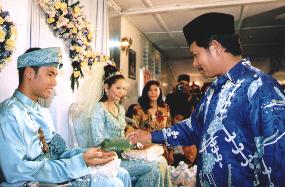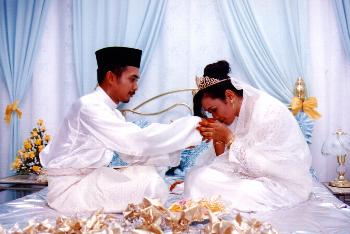For any individual, the wedding day is the best and happiest day of his/her life. It is the day where 2 individuals, vowed to commit themselves to each other. To live their life together no longer as strangers or friends, but as a family; as each other’s husband or wife.
The wedding festival of the Malays is derived from a long history of cultural assimilation and adaptation. Today, the traditional Malay wedding is a very complex and elaborated ceremony, consisting of multiple stages and religious procedures. Starting from the “merisik” to the “bersanding”, each stages bears it own significant and importance.
In the following sections, we will explore each of the steps in details and trace some of the developments in this ceremony.
Generally, the wedding comprises of a few fundamental procedures that begin with “merisik” to “meminang”, then “bernikah” and lastly “bersanding”.
 A lot of the cultures had lost its origin and some no longer exists but the wedding culture is still persisted.
A lot of the cultures had lost its origin and some no longer exists but the wedding culture is still persisted.For instance, the “Istiadat Memuja Pantai”. In this ceremony, the local fishermen believed that the “Hantu Laut” which has influence on their daily catch will be angered should they failed to satisfied its demand which usually consist of foods and other items. This myth contradicts the Islamic teaching. True Islam believed that there is no other being capable of influencing one’s life other then Allah. The worshiping of other being is considered an unforgivable sin in Islamic teaching. This had caused the society to leave “Istiadat Memuja Pantai” behind.
Unlike the “Istiadat Memuja Pantai” where it was held because it was based on threat of the “Hantu Laut”, the reason why the wedding culture still existed today is because of the willingness of individuals.For Malays, the wedding marks one of the greatest histories of their lifetime. Thus, the wedding preparation must be planned earlier. The parents should bestow the wedding.
Although the Malay society has gone through a lot of modernization, the wedding culture has changed pretty much from the original one but some are still being retained such as “mandi bunga mawar”. There is no factual reasoning why this practice is being done. One of the reasons is due to fact that they are famous and rich in possessing culture. It has been inherited from their forefathers. Furthermore, the culture can be traced back to the foreign merchants or traders from Arab and India.
In addition, the culture of giving “bunga telur” to the guest that attends the wedding has been replaced with some sweets and candies which are more practical and cost effective.
Most of the Pajan and Animism were eliminated due to the advent of Islam in the Malay society. Although the Malays have embraced Islam, some practices such as the colouring of henna on the hands of the newly wed actually stems from the belief that it will cast off the evil spirit. On the other hand, “bersanding” and “berandam” are carried out to strengthen the relationship between both families of the newly wed.
The wedding customs vary from states to states mainly due to the influence of external factors. For the example, the Siam has exerted part of their customs in the northern states whereas Negeri Sembilan mainly influenced by the Minangkabau culture. Besides that, Johor, for example embedded with Bugis tradition.
As the Malay saying goes “biar mati anak jangan mati adat”, we can see that the Malay society is very devoted to their culture. Therefore, it has to be maintained and preserve in a respectful manner because the culture depicts the people who practiced it.
